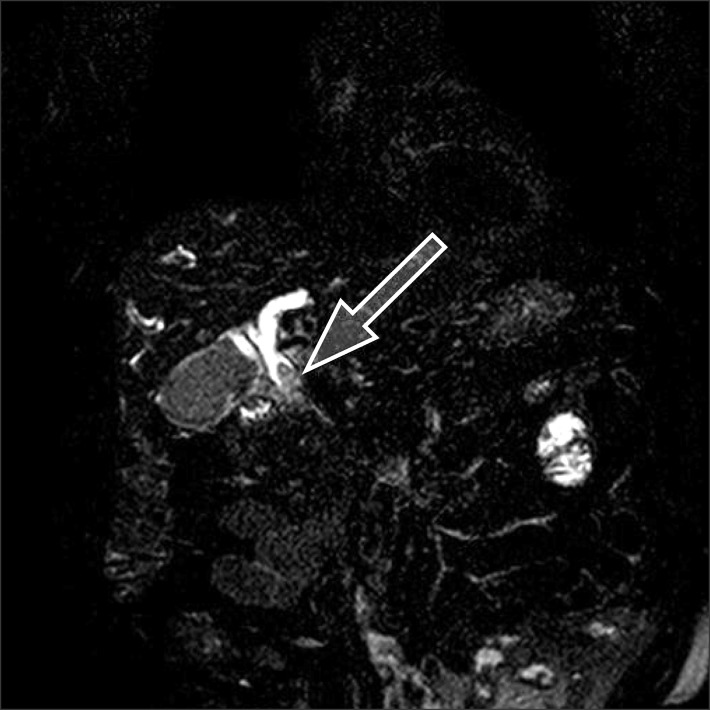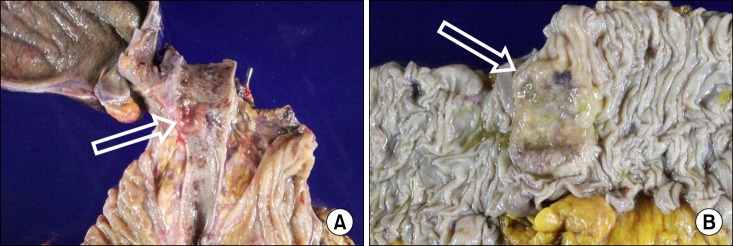INTRODUCTION
Malignant extrahepatic bile duct obstruction is mostly caused by primary bile duct cancer, or via the metastasis of other tumors to the peripancreatic, periportal, peribiliary lymph nodes, and the head of the pancreas.
1 The primary cancers that cause metastatic biliary obstruction include carcinomas from the stomach, colon, lung, uterus, and breast. Among them, common malignant tumors that could cause metastatic extrahepatic bile duct obstruction are stomach cancer and colon cancer;
23 however, biliary obstruction associated with metastatic mucinous adenocarcinoma of the colon to the distal common bile duct is even rarer in non-biliary cancers. Moreover, colonic mucinous adenocarcinoma is relatively rare, accounting for less than 5% of colorectal cancers; when it is diagnosed at an advanced stage, the prognosis is worse.
4 In the literature review, there is no report regarding metastatic mucinous adenocarcinoma of the distal common bile duct from colon cancer- thus, we present a sample case of this disease.
Go to :

CASE
A 70-year-old man presented with obstructive jaundice and weight loss, for two weeks. He did not have a history of hypertension, diabetes mellitus, tuberculosis and liver disease. Upon a physical examination, the patient did not appear to be so ill-looking, and showed icteric sclera. A laboratory evaluation revealed obstructive jaundice with a total bilirubin of 5.4 mg/dl, alkaline phosphatase of 640 IU/L, aspartate aminotransferase of 573 IU/L, and alanine aminotransferase of 841 IU/L. The carcinoembryonic antigen (CEA) was 2.4 ng/ml, the alpha-fetoprotein was 3.05 ng/ml, and the carbohydrate antigen 19-9 (CA19-9) was 61 U/ml. Abdominal computed tomography (CT) scan, and abdominal magnetic resonance imaging detected a 2.5 cm-sized enhancing soft tissue lesion at the distal common bile duct, with involvement of the cystic duct and gallbladder neck, thus narrowing the common hepatic duct and dilating the proximal duct, by which bile duct cancer was suspected (
Fig. 1). In addition, they showed eccentric enhancing wall thickening in the proximal transverse colon, which is suggestive of concomitant colon cancer (
Fig. 2). Colonoscopy revealed a lumen-encircling ulcerofungating mass in the proximal transverse colon that was pathologically proven to be adenocarcinoma. Endoscopic retrograde cholangiopancreatography (ERCP) was performed to relieve obstructive jaundice, and to confirm the tissue pathology of the bile duct lesion as well. The bile duct pathology was also proven to be adenocarcinoma.
 | Fig. 1Preoperative imaging study: A biliary magnetic resonance imaging shows a 2.5 cm mass (arrow) in the distal common bile duct on axial image, suggestive of bile duct cancer.
|
 | Fig. 2Preoperative imaging study: (A) An abdominal computed tomography scan showed eccentric enhancing wall thickening (arrow) in the proximal transverse colon; (B) A colonoscopy revealed a lumen-encircling ulcerofungating mass in the proximal transverse colon that was pathologically proven to be adenocarcinoma.
|
Pylorus-preserving pancreaticoduodenectomy and extended right hemicolectomy were performed under the diagnosis of double primary cancers, at the common hepatic bile duct and transverse colon (
Fig. 3). A postoperative histopathologic examination revealed a moderately differentiated mucinous adenocarcinoma of the transverse colon cancer (pT4aN2b; 14 out of 35 lymph nodes) and a mucinous adenocarcinoma of the distal common bile duct (pT2N1; 2 out of 4 lymph nodes). Immunohistochemical staining studies showed cytokeratin 7 (-), cytokeratin 19 (+), cytokeratin 20 (+), CDX2 (+), and p53 (-), by which we concluded that the bile duct cancer had metastasized from colon cancer (
Fig. 4). The patient recovered uneventfully from surgery, and will be undergoing adjuvant systemic chemotherapy for three months.
 | Fig. 3Photographs of the gross specimen: (A) A 1×1 cm-sized round ulcerative mass (arrow) is shown at the distal common bile duct; (B) Another 3×4 cm-sized ulcerofungating mass (arrow) is identified at the proximal transverse colon.
|
 | Fig. 4Histologic findings of the common bile duct: Immunohistochemical staining showed a cytokeratin 7 (-) and cytokeratin 20 (+) staining pattern, which is a characteristic of biliary metastasis from colorectal cancer. (A) A photomicrograph shows intraductal metastatic mucin-filled lesion invades the extraductal space of the posterior distal bile duct (H&E, ×12.5). (B and C) Photomicrographs, obtained after immunohistochemical staining with anti-cytokeratin 7 and anti-cytokeratin 20 antibodies, showing that tumor cells were negative for cytokeratin 7 and positive for cytokeratin 20.
|
Go to :

DISCUSSION
Patients with primary bile duct cancers typically present with painless jaundice resulting from the perihilar or distal biliary strictures, or with an intrahepatic mass, causing abdominal pain. Common non-biliary malignancies that can cause distal biliary obstruction are: stomach cancer, colon cancer and breast cancer;
2 however, biliary obstruction caused by mucinous adenocarcinoma of the colon is rare, and is mostly due to the compression of the bile duct by metastasis to the surrounding the lymph nodes, or to the pancreas head.
The most frequent site of metastatic malignant biliary obstruction is the common bile duct, at the level of the cystic duct.
5 In general, metastatic lymphadenopathy in the hepatoduodenal ligament is the main cause of biliary obstruction.
6 According to some reports, however, the hepatic hilum was the most common level of obstruction.
78 Moon et al. reported that the proximal common bile duct (20/50, 40%) and hilum (18/50, 36%) were the most frequent levels of biliary obstruction, followed by the periampullary area (14%) and the distal common bile duct (10%), because of biliary obstruction in metastatic cancer.
2 In this case, the abdominal CT showed a 2.5 cm-sized enhancing soft tissue lesion in the distal common bile duct, causing a biliary obstruction.
Even though the status of the primary extra-biliary malignant disease can affect the therapeutic strategy for double primary intraductal cholangiocarcinoma, radical surgical resection is still an option if the primary extra-biliary malignancy is well controlled.
3 There is no concrete evidence, however, that the surgical resection of metastatic lesions (including intraductal lesions) increases patient survival unless the patient has hepatic metastasis resulting from colorectal cancer. In our case, pylorus-preserving pancreatoduodenectomy, with extended right hemicolectomy, was performed under the diagnosis of double primary cancers of the common hepatic bile duct and transverse colon. In preoperative imaging evaluation, there was no evidence of metastasis originating from the double primary cancers.
When an intraductal lesion was detected on the CT images of a patient with extra-biliary neoplasm, the following findings were found to be suggestive of intraductal metastasis, rather than intraductal cholangiocarcinoma: colorectal cancer as the extra-biliary malignant disease, a parenchymal mass that was contiguous with the intraductal lesion, and expansile growth of the intraductal lesion.
3 The significant point that differentiates intraductal metastasis from intraductal cholangiocarcinoma was the morphologic features of the intraductal lesion. The appearance of the intraductal lesion in pathologic specimens differed for intraductal metastasis and intraductal cholangiocarcinoma, which contributed to the differences in the diagnostic imaging features.
9 In the intraluminal extension, the tumor grows in the ductal lumen as papillary projections, resembling tumor thrombi. However, in the intraepithelial extension, the cancer cells advance along the intact basement membranes and replace the non-neoplastic biliary ductal epithelium. Usually, intraductal metastasis exhibits expansile intraluminal extension, but intraductal cholangiocarcinoma exhibits intraepithelial extension with a papillary growth pattern, due to its origination from the underlying papilloma or adenoma.
10
We performed immunohistochemical staining studies, as an additional tool for the differentiation of intraductal metastasis and intraductal cholangiocarcinoma. The immunohistochemical reaction to cytokeratin, such as cytokeratin 7 and cytokeratin 20, is well known to enhance the diagnosis.
9 The colorectal epithelium is immunoreactive to the anticytokeratin 20 antibody, but not to anticytokeratin 7 antibody, which is reactive to biliary epithelium. Therefore, a cytokeratin 20-positive and cytokeratin 7-negative immunohistochemical staining pattern is a characteristic of biliary metastasis from colorectal cancer.
11 Cytokeratin 19 is normally expressed in the lining of the gastropancreatic and hepatobiliary tracts, which is positive in most adenocarcinomas in the gastrointestinal tract and pancreas.
12 The expression of CDX2 in adults is restricted to the intestine, from the duodenum to the rectum. CDX2 is regarded as a specific marker of the intestinal epithelial cells, that can be utilized for identifying the colorectal origin of metastatic adenocarcinomas.
13 p53 is a tumor suppressor gene that is located on the short arm of chromosome 17, and the p53 mutation is required for the development of colorectal cancer, and is associated with an increased relative risk of death, and poorer prognosis.
114
In conclusion, we should take metastatic lesions into consideration, when an intraductal lesion is found in a patient with colorectal malignancy, or a history of colorectal cancer. To our knowledge, this is the first report regarding metastatic mucinous adenocarcinoma of the distal common bile duct, resulting from colon cancer.
Go to :









 PDF
PDF ePub
ePub Citation
Citation Print
Print


 XML Download
XML Download